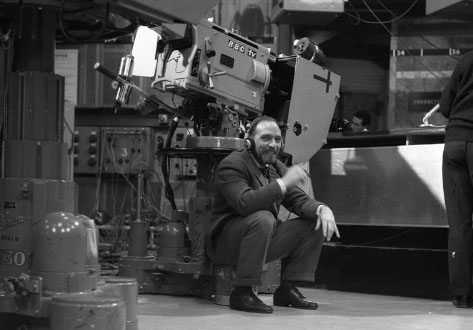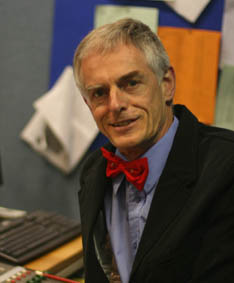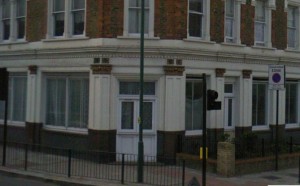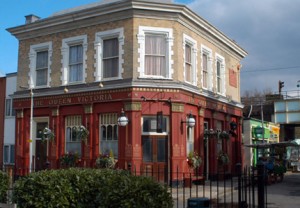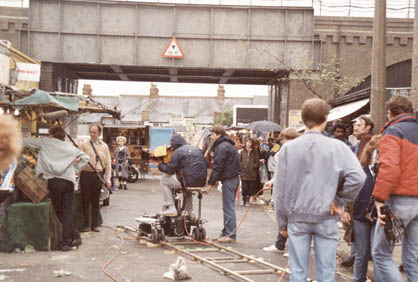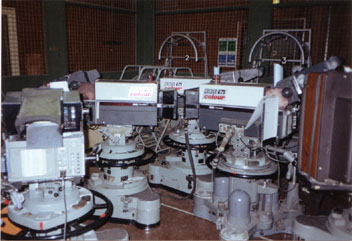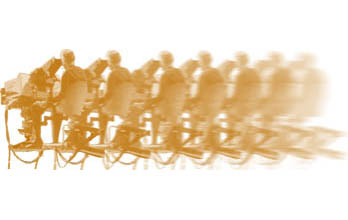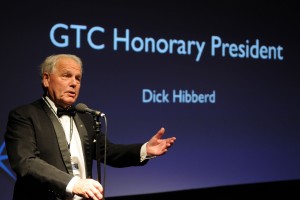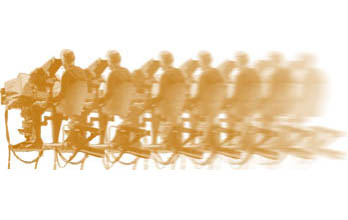Here are two not-tech-ops stories about Pres B
These are re-prints from stuff I’ve written elsewhere……..
Pres B was a small studio on the fourth-and-a-half floor of Television Centre. It isn’t there now, as it was destroyed for some network control rooms that were used for a very few years then abandoned. Pres B was pretty historic, as it had hosted Late Night Line Up and it’s descendants such as Colour Me Pop and Old Grey Whistle Test, and lots more. The famous mechanical Christmas Symbols lived there for a few days each year. It had hosted Film 90-something since Film 90-something had been Film 70-something, and also Points of View.
When Producer Choice came along, the studio scheduling department became a cost centre, renting building space (the studios) from Premises Operations, and selling it on to productions. As the selling process went through, the overhead cost grew heavy with the weight of employing more accountants, on top of the weight of the film library, the gram library, the programme complaints department, etc etc. So BBC studios cost more than outside studios, and as producers could choose to work anywhere, they took their BBC money – which could have been spent inside on facilities owned by the BBC – and spent it elsewhere, turning it from an internal cost to real cash – effectively chucking money away. It made sense on a producer’s budget sheet though, because they spent less of it at Teddington – or wherever – than they did in the building where their office was.
The producer of Film 90-something, Bruce Thompson, and the producer of Points of View, me, Bernard Newnham, thought all this was pretty stupid, and carried on using Pres B. It was a few yards from my office, so very sensible and convenient to use.
Then things started to go wrong for the studio schedulers. They couldn’t balance their budget – the one they didn’t have before Producer Choice. Their “customers” – as they were now, rather than colleagues – were producers with cash budgets that were always being cut back. The producers made savings on their balance sheet by going outside, or turning the office into a studio. So the main studios weren’t being used, but the studio people’s overheads didn’t go away. They needed to cut back, so they – for reasons I don’t know – decided to close Pres B, and stop paying rent to Premises Operations for it. They put a padlock on the door so we couldn’t sneek in.
Studio Operations set Points of View up with alternative locations, initially in the under-used large studios. It was very strange to do PoV in TC1 – 100x100x50, built for huge operas and LE shows. We were in a tiny corner. Then one autumn they didn’t have any room, so they offered us 13 weeks at Elstree. We had a disused studio – B, I think – with our own small OB truck outside next to an OB VT truck. It was all quite fun, apart from the cost of going there each week, which was added to our budget so we could afford it. After the quarter was up, we went back to touring the big studios.
Then one day, on the way to an edit, I bumped into our studio scheduler lady in the corridor “I’ve been meaning to tell you”, she said, ”we don’t have a studio for you next week”.
“What????”
Points of View was, in those days, a BBC1 staple – 8.50 Wednesday evening every week for years . “I’m sorry but we’re unable to bring you Points of View this week, as a studio wasn’t available” . In earlier days they would have fallen on their sword rather than not give us a studio, but now we were just a rather minor customer. 9 million viewers each week meant nothing.
Enough, I thought, and joined in the game. I called OBs and asked the boss a hypothetical question. Then I called Head of Premises Operations and asked if I could rent his Pres B for a day each week.
“It belongs to Studios” he said.
“No it doesn’t, they gave it back to you – put a padlock on the door”.
“It has their gear in it”.
“Doesn’t matter, OBs will bring a truck round the back and run cables over the roof, it’ll be an OB”.
“I’ll have to think about this….”
In the meantime I needed a studio in a few days, and after various trips and discussions, went to SSVC at Chalfont.
Then, completely unannounced, I got a memo from Studio Operations – they’d agreed with Premises Operations to only rent Pres B from them on days when they had a booking, thus paying no pretend money when they weren’t getting pretend money from us.
They removed the padlock. I had played the silly Producer Choice game and won.
So after one week at SSVC, we, and Film thing, were back in Pres B as if we’d never been away. What a wonderful thing Producer choice was.
++++++++++++++++++++++++++++++++++++++++++++++++
And……
Making a trail for a Hitchhiker radio programme on TV – where the pictures aren’t all in your head.
First go to http://www.tech-ops.co.uk/bern/h1.wmv where you will find a somewhat battered copy of the subject of this piece.
January 1980…..
I must admit that the Hitchhikers Guide to the Galaxy passed me by when it was first on radio. Given that I spent huge amounts of time working in television and actually being at TV Centre, it isn’t too surprising. As a promotions producer in the BBC Presentation department I worked a three weeks on and one week off shift pattern, month after month, with very long days in the building. We really didn’t get out much, and we slept away much of the week off.
In each block of three weeks, the three members of a promotions team generally made 10-15 trails – that’s not including “next week, tomorrow, tonight” versions of the same thing – all for programmes in the “operational week”, the third one. The most prestigious and difficult thing was regarded as the Radio Times trail. Of course, this was really an advert, and rather against the rules, but had been made since time immemorial so had kind of grandfather rights. What you had to do was make a trail for one or more programmes, and sort of notice that they were the ones featured in this week’s Radio Times. It was regarded as a chance to be original, and given the pressure of time, was often the only chance there was to do something that wasn’t just programme clips edited together.
Most Radio Times front covers featured a tv programme, but radio was grudgingly allocated a certain number each year. In week 4 1980 (19-25th January) it was their week, and they picked Hitchhiker. Series one was being stripped through the week as a intro to series two, so although series one had been on several times before, this was in effect a high profile launch. As tv promotions producer for that week, I first took notice of the things we would have to trail around the back end of the previous promotions cycle, before the off week. I discovered that there was an LP of the first Hitchiker series and got hold of it from BBC Records. This was the first time I’d listened to the series and I quite enjoyed it, though I wouldn’t say I was a huge fan. It has to be said that after 14 years in tv by then, and having worked on many programmes in my days as a cameraman, I could never really be a huge fan of anything made in the factory where I worked. We used to play inside Daleks in the scenery runway, whilst Dr Who fans obsessed outside the gates
What you could always do with a radio cover was chicken out and do a few tv programmes featured inside the magazine and just mention the cover story in passing. Unless I had a workable idea I was certainly going to do exactly that. I must admit that the challenge of making a trail for a fantasy radio programme did appeal, but I needed a visual idea which I would have to think up myself. After this long time I have no memory at all about how the idea came into my head. Actually, one thing I’ve discovered is that I can never work out where original ideas come from. They don’t happen too often, and seem to just pop into your head. In this case, before the “chicken out” deadline came along, I had that good idea. I would show a version of the Guide, though not an actual book – at least, not one for humans. I decided that out there somewhere in the universe aliens would have a prism as the book. I thought that if I shone different colours of light through the prism I would get appropriate rainbow effects – sort of words for aliens. This was of course well before the age when computers would do this sort of tv effect. When the Hitchhiker tv dramatisation came along the following year they would use prosthetics, plywood and 35mm film animations, and they had a decent budget.
When the cycle of week 4 began on Monday of week 2 and ten days before the first transmission of the Radio Times trail on the Wednesday of week 3, I asked the props people to find whatever prisms they could come up with. I wrote a script for Peter Jones and got in touch with Geoffrey Perkins, the producer. It turned out that they were making series 2 at that moment, so it would be convenient for me to go along and have Peter record my material during their time. From endless trail making I had an ability to mimic styles of writing of various shows, and the team, presumably including Douglas Adams, happily accepted what I had written. Mr Adams wasn’t a familiar face in those days, so I have no idea whether he was there or not. Peter recorded his piece onto quarter inch tape.
Back at TV Centre I asked our senior graphics designer to Letraset “Don’t Panic” onto the end of one of the prisms that had turned up from props. I do remember him saying “just that?”. He obviously hadn’t heard the programme either. Lying around in the corner of the office was a sheet of card with a shiny textured surface, also a trainee, a somewhat irritating one, to hold it up and wiggle it as required. The promotions turntable would come in useful too. That was it until the day in the studio, Wednesday of week 3, a few hours before transmission. I had a dozen or so other trails to make.
On the Wednesday we had the afternoon studio session scheduled to us. It would start as always at 14.30 and run till 17.00. That was our slot, with no extensions, and we would have had a good number of other trails to make in addition to the Radio Times. The good thing was that nothing else would need much in the studio itself, apart from the odd caption or two, so I could set up with plenty of time and space. We were working in Pres B, as our studio, Pres A next door, was being refurbished. Pres B is famous as the original Old Grey Whistle Test studio, and I as I write this the tv is running Guitar Heroes at the BBC on BBC4, with a video of The Who playing in the same small studio. I pulled around the black cyclorama as a background and set up the prisms that I had in a group on the turntable and set it going. I have to admit that I still didn’t quite know what it was all going to look like. What I wanted was a fan of rainbow light which would vary over time, or something that would convey a similar weirdness.
It didn’t work. I had forgotten that what I really needed for the effect was sunlight, and that was one thing that wasn’t available. Also the prisms were props, and although I’m sure that the law of optical dispersion still worked, it didn’t work well with tungsten light on not-very-clear glass.
Luckily, because I had never been sure of what result I would get, I had various backups. One was the good old Dr Who opening titles howl round. Point a camera at a monitor showing it’s own output, and you get the video equivalent of putting a microphone in front of a louspeaker. The camera moves around whilst you mix in a second camera with – in this case – a pile of prisms, and you get lots of piles of prisms. Spooky. The lighting man set up drastic variations in the colours of the lights and cycled through them. The trainee waggled his shiny board in the background. Peter Jones was played back from tape. And it sort of worked. I had a scene crew man with a smoke machine to add even more visual mystery. He filled the small studio with smoke, but hard as he tried, we couldn’t really see much of it. Never mind – after a few takes we decided we had something weird enough for a fantasy radio programme trailed on television.
The Radio Times front page at the end of the trail was zoomed up using the Blue Peter ship technique. This was done on the end of every BP show at the time. You mount the ship picture – or RT cover – on a 20x16in caption card and put that on a stand in the studio. Then you have the cameraman zoom all the way out. This reveals much of the studio, so the card is lit brightly with a spotlight. The iris on the camera has to be closed right down, and everything except what’s on the card disappears. Crash zoom in on cue and it’s done.
And that was it. The Radio Times trail was always shown from Wednesday to Friday, maybe 6 or so transmissions, then it was gone forever. But most of us liked to keep some of the things that we made, and at that time we saved them on Philips cassette. Eventually we moved on to VHS, and I copied my stuff across using a dying Philips machine and a sticking tape. So the quality of my early stuff isn’t too good. The 2″ masters are of course long gone, but that’s television. At least I have a sort of reasonable copy of something ephemeral – and trails are about as ephemeral as tv gets.
…oh – when I left the studio, I ran into the BBC1 continuity announcer, a pleasant but rather, er…. precious man. It turned out that the aircon in Pres B recirculated through the whole presentation area, so my smoky studio became everyone’s smoky working area. He said “I’m not going back in there till they put the fire out”, and wouldn’t believe it was just me. Smoke was never allowed in the area again.
Bernard Newnham
11/07/2009 – 29 years on.

